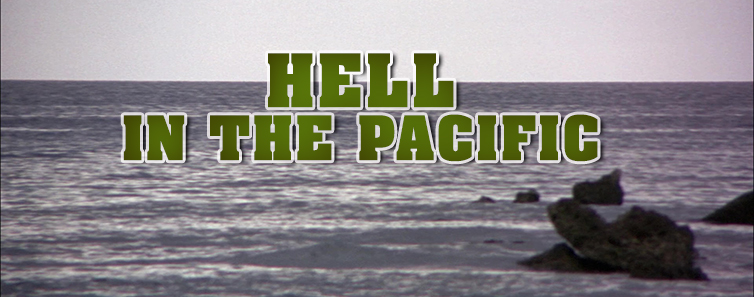
Color, 1968, 103 mins. 10 secs. / 101 mins. 47 secs.
Directed by John Boorman
Starring Lee Marvin, Toshirô Mifune
Kino Lorber (Blu-ray & DVD) (US RA/R1 HD/NTSC) / WS (2.35:1) (16:9), MGM (DVD) (US R1 NTSC) / WS (2.35:1)
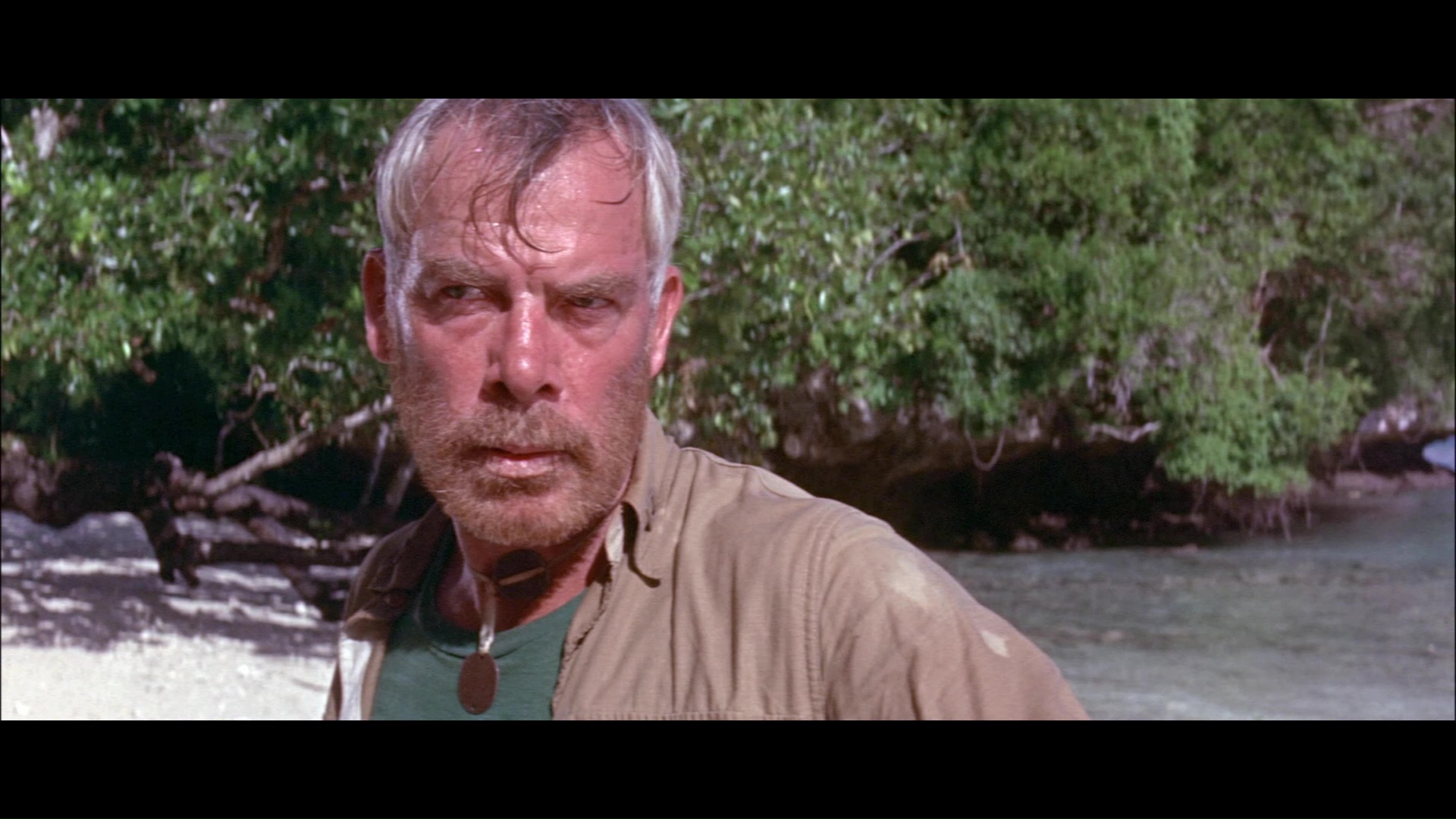
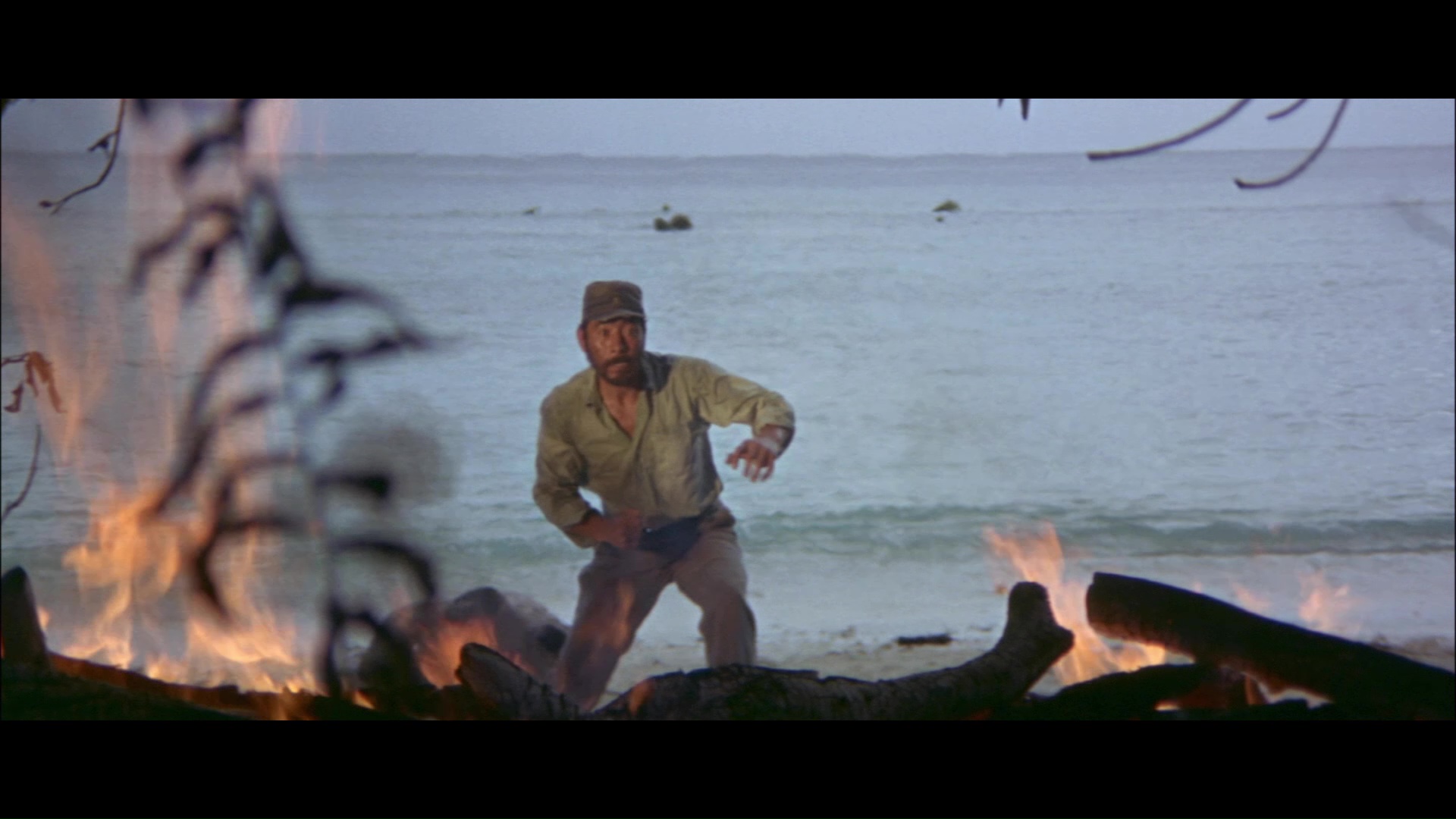 Hot off of an Oscar win for Cat Ballou, actor Lee Marvin reteamed with his Point Blank director John Boorman to appear in a challenging project featuring only two actors and with Marvin delivering the only English dialogue heard on the soundtrack. Joining him was one of the most formidable leading men in world cinema, Toshirô Mifune, at the peak of his popularity via Akira Kurosawa films despite the fact that the legendary actor-director duo had parted ways under stormy circumstances during Red Beard three years earlier. The end result was Hell in the Pacific, a costly financial disappointment and turbulent experience that often pitted Boorman against both Mifune and the film's producers including Henry G. Saperstein, who had recently come up with the idea of turning an imported Japanese spy film into Woody Allen's What's Up, Tiger Lily?
Hot off of an Oscar win for Cat Ballou, actor Lee Marvin reteamed with his Point Blank director John Boorman to appear in a challenging project featuring only two actors and with Marvin delivering the only English dialogue heard on the soundtrack. Joining him was one of the most formidable leading men in world cinema, Toshirô Mifune, at the peak of his popularity via Akira Kurosawa films despite the fact that the legendary actor-director duo had parted ways under stormy circumstances during Red Beard three years earlier. The end result was Hell in the Pacific, a costly financial disappointment and turbulent experience that often pitted Boorman against both Mifune and the film's producers including Henry G. Saperstein, who had recently come up with the idea of turning an imported Japanese spy film into Woody Allen's What's Up, Tiger Lily?
The minimal story here follows the conflicts and survival techniques of two men from opposing sides during World War II, an American pilot (Marvin) and a Japanese naval captain (Mifune), when they wind up stranded on a remote Pacific island. Their ingrained training and patriotism are often at odds as they vie for dominance and come up with ways to make their lives better, even if it means keeping secrets or stealing from each other in the process. When the opportunity finally comes to get off the island, they must finally decide whether they can overcome their ideological divide and make it back to civilization alive.
Boorman undertook this film with the idea that Marvin would 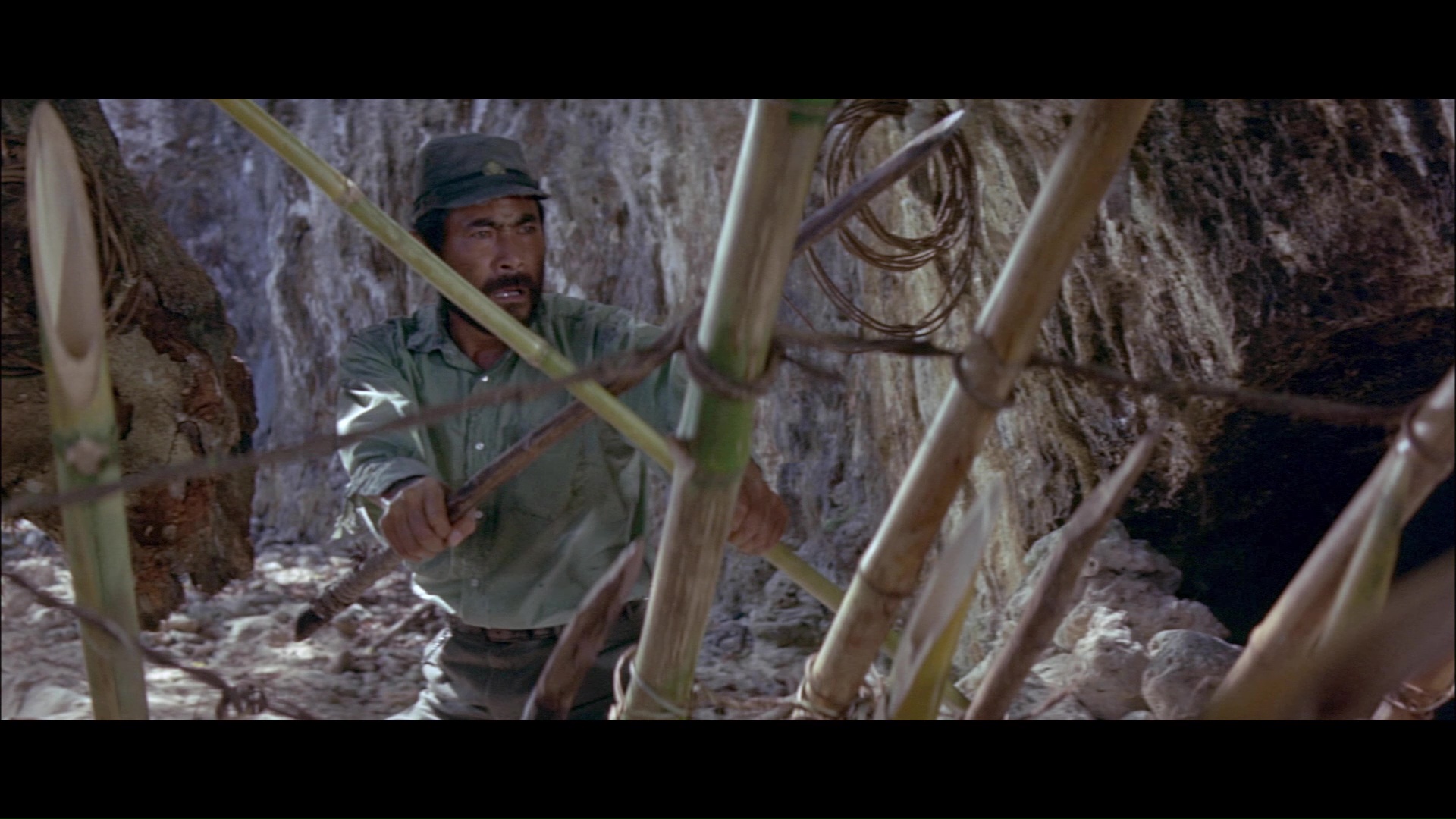 speak English and Mifune would only speak Japanese, with no subtitle options for
speak English and Mifune would only speak Japanese, with no subtitle options for 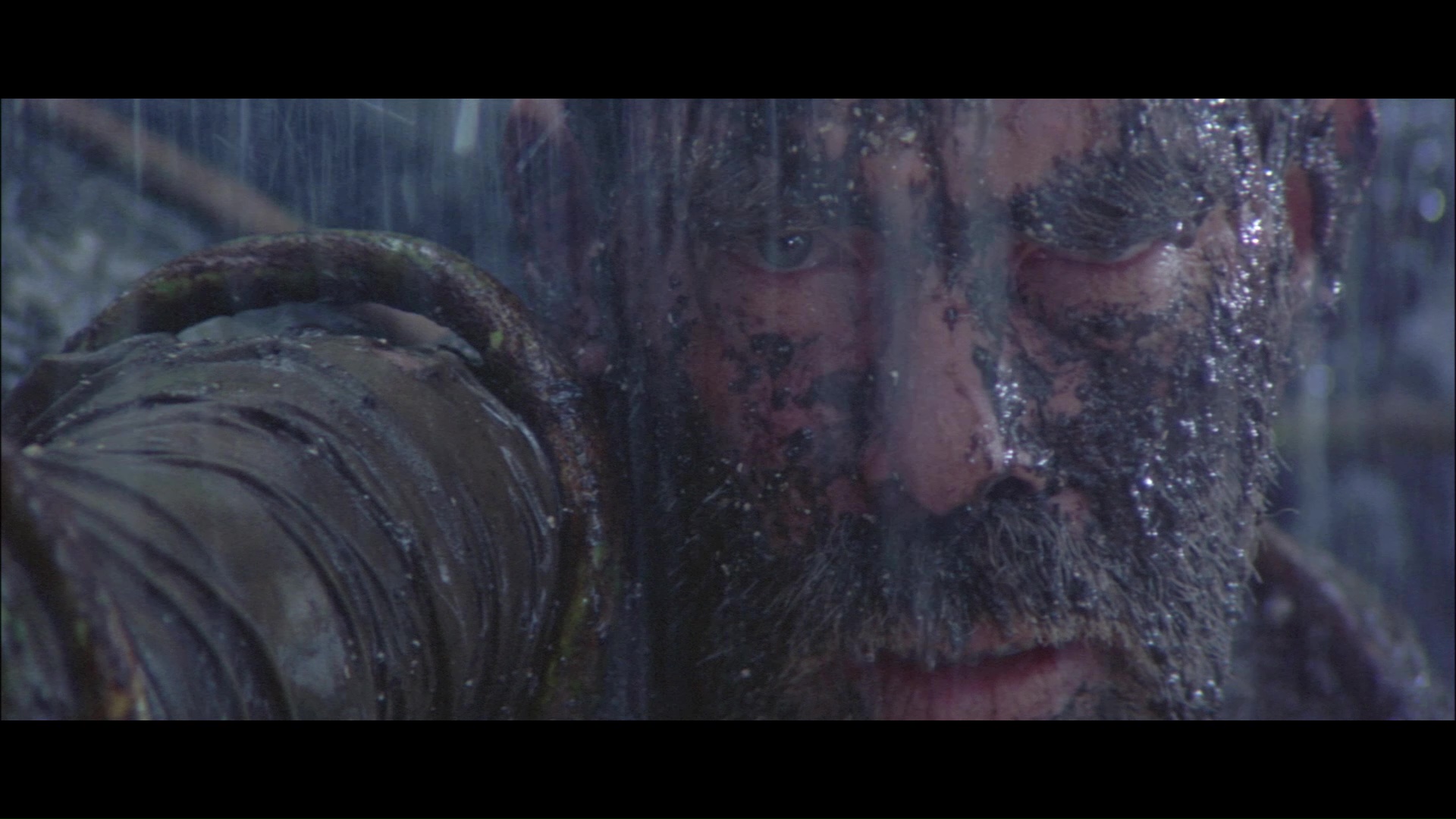 either English-speaking or Japanese-speaking audiences (who would obviously get very different viewing experiences in the process). Both actors give raw, committed performances boosted by a percussive, often abrasive score by Lalo Schifrin that still divides many viewers, and the superb cinematography by the late Conrad Hall (whose childhood in Tahiti proved useful capturing the light and textures here) is just as impressive as his more famous work around this time on In Cold Blood, Cool Hand Luke, and Butch Cassidy and the Sundance Kid. Whether the extreme strain involved in making the film is an asset is up for debate (as it even sent an exhausted Boorman into a nearly two-year hiatus), but the end result is a memorable experience that's only become more interesting over the ensuing years.
either English-speaking or Japanese-speaking audiences (who would obviously get very different viewing experiences in the process). Both actors give raw, committed performances boosted by a percussive, often abrasive score by Lalo Schifrin that still divides many viewers, and the superb cinematography by the late Conrad Hall (whose childhood in Tahiti proved useful capturing the light and textures here) is just as impressive as his more famous work around this time on In Cold Blood, Cool Hand Luke, and Butch Cassidy and the Sundance Kid. Whether the extreme strain involved in making the film is an asset is up for debate (as it even sent an exhausted Boorman into a nearly two-year hiatus), but the end result is a memorable experience that's only become more interesting over the ensuing years.
As part of the ABC Films library following its initial theatrical release from Cinerama, Hell in the Pacific had a very tattered history on DVD from both Anchor Bay in 1999 and MGM in 2004, each featuring a very lackluster flat letterboxed transfer that did the film very few visual favors. Both releases featured the abridged cut with the clumsy explosion ending imposed in every country but France, while Boorman's preferred "alternate ending" was tacked on as an extra. However, the MGM disc had a fascinating feature: the optional English, French or Spanish subtitles also translated all of Mifune's dialogue, allowing viewers to understand both performances in full. The subtitles on that disc are huge and clunky, but it was a nice option and really a more engrossing way of experiencing the film.
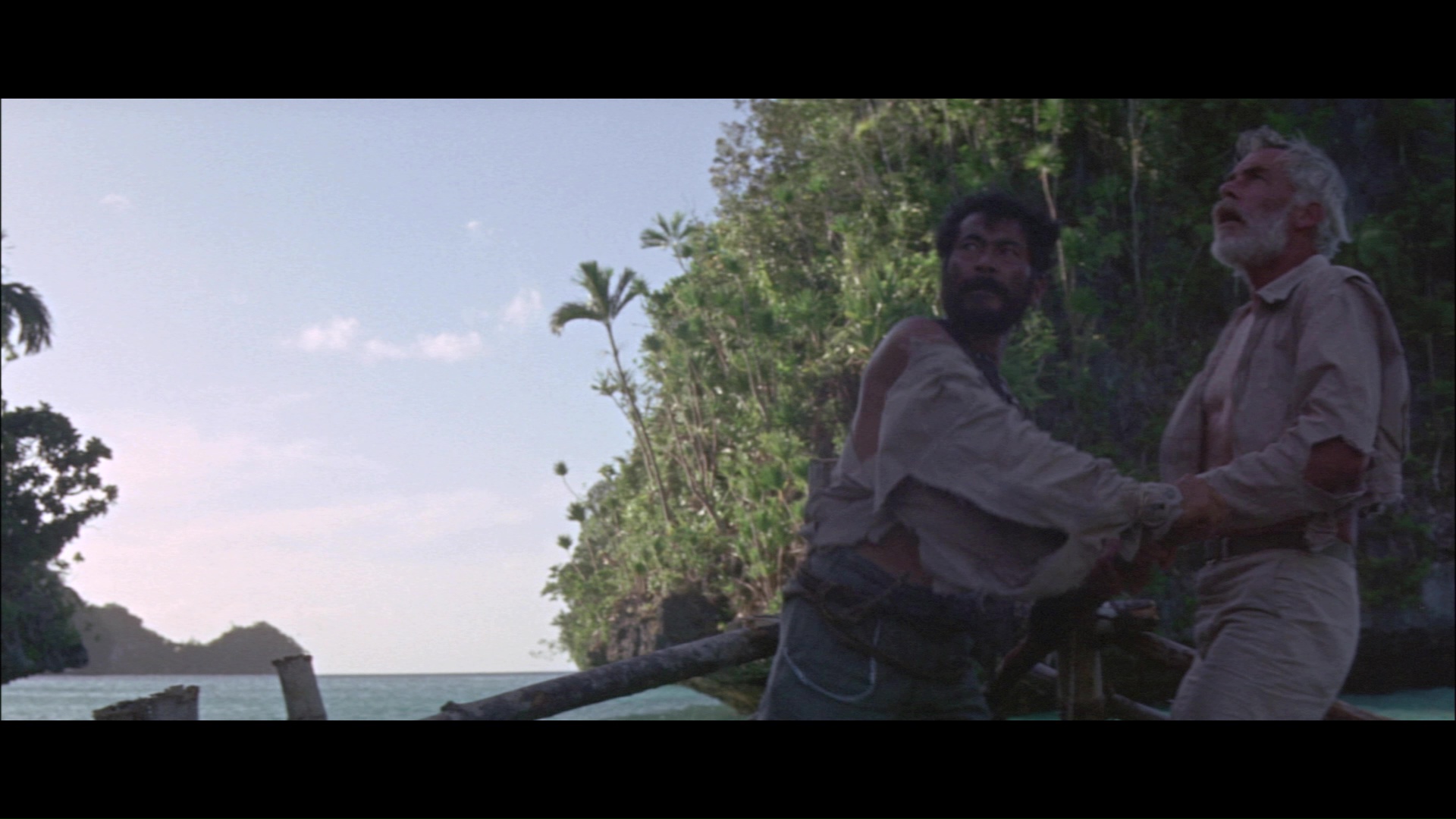 The 2017 release from Kino Lorber treats the film far more respectfully with an option to watch either cut of the film in its entirety (go with the alternate ending for your first viewing), and the image quality is a massive leap forward in every possible way. The film isn't the crispest in the world given the frequent hazy sunlight, but this is so much better than anything we've had before it's quite remarkable. The DTS-HD MA English stereo track sounds excellent, and thankfully the English subtitles here also retain the
The 2017 release from Kino Lorber treats the film far more respectfully with an option to watch either cut of the film in its entirety (go with the alternate ending for your first viewing), and the image quality is a massive leap forward in every possible way. The film isn't the crispest in the world given the frequent hazy sunlight, but this is so much better than anything we've had before it's quite remarkable. The DTS-HD MA English stereo track sounds excellent, and thankfully the English subtitles here also retain the 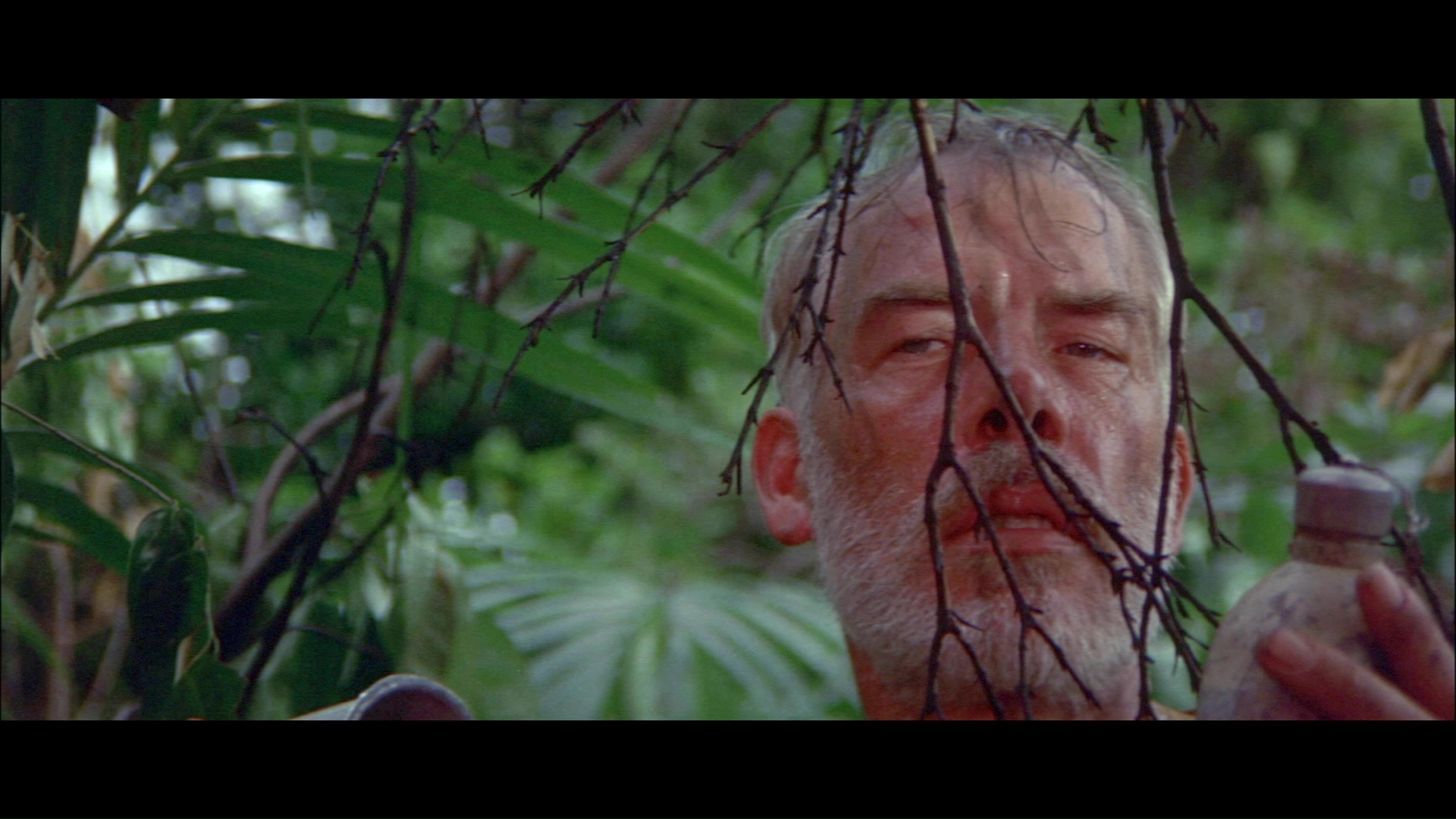 translation for Mifune's dialogue. Also included is a new audio commentary by Bill Ackerman and Travis Crawford, a very thorough and engaging chat that covers Boorman's career in depth (with a focus on Point Blank, obviously), the tension between Mifune and the director over translation and multiple script issues, the camaraderie between the two leads over their love of drinking, and plenty more. Boorman chimes in with a new interview, "Man vs. Man" (33m16s), recalling how he brought the two leads on board, storyboarded the project, the "huge loss of face" that could have disrupted the shoot, and the circumstances that made it both the "best and worst experience I've ever had." Then art director Anthony Pratt appears for a featurette (10m46s) covering the technical challenges of shooting a film almost chronologically with only two actors, including further memories about the bumpy relationship between Boorman and Mifune (who did wind up becoming close friends after the shoot was over). Also included are bonus trailers for Prime Cut, The Challenge, The Spikes Gang, Gorky Park, and The Emerald Forest.
translation for Mifune's dialogue. Also included is a new audio commentary by Bill Ackerman and Travis Crawford, a very thorough and engaging chat that covers Boorman's career in depth (with a focus on Point Blank, obviously), the tension between Mifune and the director over translation and multiple script issues, the camaraderie between the two leads over their love of drinking, and plenty more. Boorman chimes in with a new interview, "Man vs. Man" (33m16s), recalling how he brought the two leads on board, storyboarded the project, the "huge loss of face" that could have disrupted the shoot, and the circumstances that made it both the "best and worst experience I've ever had." Then art director Anthony Pratt appears for a featurette (10m46s) covering the technical challenges of shooting a film almost chronologically with only two actors, including further memories about the bumpy relationship between Boorman and Mifune (who did wind up becoming close friends after the shoot was over). Also included are bonus trailers for Prime Cut, The Challenge, The Spikes Gang, Gorky Park, and The Emerald Forest.
Reviewed on July 4, 2017.



 Hot off of an Oscar win for Cat Ballou, actor Lee Marvin reteamed with his Point Blank director John Boorman to appear in a challenging project featuring only two actors and with Marvin delivering the only English dialogue heard on the soundtrack. Joining him was one of the most formidable leading men in world cinema, Toshirô Mifune, at the peak of his popularity via Akira Kurosawa films despite the fact that the legendary actor-director duo had parted ways under stormy circumstances during Red Beard three years earlier. The end result was Hell in the Pacific, a costly financial disappointment and turbulent experience that often pitted Boorman against both Mifune and the film's producers including Henry G. Saperstein, who had recently come up with the idea of turning an imported Japanese spy film into Woody Allen's What's Up, Tiger Lily?
Hot off of an Oscar win for Cat Ballou, actor Lee Marvin reteamed with his Point Blank director John Boorman to appear in a challenging project featuring only two actors and with Marvin delivering the only English dialogue heard on the soundtrack. Joining him was one of the most formidable leading men in world cinema, Toshirô Mifune, at the peak of his popularity via Akira Kurosawa films despite the fact that the legendary actor-director duo had parted ways under stormy circumstances during Red Beard three years earlier. The end result was Hell in the Pacific, a costly financial disappointment and turbulent experience that often pitted Boorman against both Mifune and the film's producers including Henry G. Saperstein, who had recently come up with the idea of turning an imported Japanese spy film into Woody Allen's What's Up, Tiger Lily?  speak English and Mifune would only speak Japanese, with no subtitle options for
speak English and Mifune would only speak Japanese, with no subtitle options for  either English-speaking or Japanese-speaking audiences (who would obviously get very different viewing experiences in the process). Both actors give raw, committed performances boosted by a percussive, often abrasive score by Lalo Schifrin that still divides many viewers, and the superb cinematography by the late Conrad Hall (whose childhood in Tahiti proved useful capturing the light and textures here) is just as impressive as his more famous work around this time on In Cold Blood, Cool Hand Luke, and Butch Cassidy and the Sundance Kid. Whether the extreme strain involved in making the film is an asset is up for debate (as it even sent an exhausted Boorman into a nearly two-year hiatus), but the end result is a memorable experience that's only become more interesting over the ensuing years.
either English-speaking or Japanese-speaking audiences (who would obviously get very different viewing experiences in the process). Both actors give raw, committed performances boosted by a percussive, often abrasive score by Lalo Schifrin that still divides many viewers, and the superb cinematography by the late Conrad Hall (whose childhood in Tahiti proved useful capturing the light and textures here) is just as impressive as his more famous work around this time on In Cold Blood, Cool Hand Luke, and Butch Cassidy and the Sundance Kid. Whether the extreme strain involved in making the film is an asset is up for debate (as it even sent an exhausted Boorman into a nearly two-year hiatus), but the end result is a memorable experience that's only become more interesting over the ensuing years. The 2017 release from Kino Lorber treats the film far more respectfully with an option to watch either cut of the film in its entirety (go with the alternate ending for your first viewing), and the image quality is a massive leap forward in every possible way. The film isn't the crispest in the world given the frequent hazy sunlight, but this is so much better than anything we've had before it's quite remarkable. The DTS-HD MA English stereo track sounds excellent, and thankfully the English subtitles here also retain the
The 2017 release from Kino Lorber treats the film far more respectfully with an option to watch either cut of the film in its entirety (go with the alternate ending for your first viewing), and the image quality is a massive leap forward in every possible way. The film isn't the crispest in the world given the frequent hazy sunlight, but this is so much better than anything we've had before it's quite remarkable. The DTS-HD MA English stereo track sounds excellent, and thankfully the English subtitles here also retain the  translation for Mifune's dialogue. Also included is a new audio commentary by Bill Ackerman and Travis Crawford, a very thorough and engaging chat that covers Boorman's career in depth (with a focus on Point Blank, obviously), the tension between Mifune and the director over translation and multiple script issues, the camaraderie between the two leads over their love of drinking, and plenty more. Boorman chimes in with a new interview, "Man vs. Man" (33m16s), recalling how he brought the two leads on board, storyboarded the project, the "huge loss of face" that could have disrupted the shoot, and the circumstances that made it both the "best and worst experience I've ever had." Then art director Anthony Pratt appears for a featurette (10m46s) covering the technical challenges of shooting a film almost chronologically with only two actors, including further memories about the bumpy relationship between Boorman and Mifune (who did wind up becoming close friends after the shoot was over). Also included are bonus trailers for Prime Cut, The Challenge, The Spikes Gang, Gorky Park, and The Emerald Forest.
translation for Mifune's dialogue. Also included is a new audio commentary by Bill Ackerman and Travis Crawford, a very thorough and engaging chat that covers Boorman's career in depth (with a focus on Point Blank, obviously), the tension between Mifune and the director over translation and multiple script issues, the camaraderie between the two leads over their love of drinking, and plenty more. Boorman chimes in with a new interview, "Man vs. Man" (33m16s), recalling how he brought the two leads on board, storyboarded the project, the "huge loss of face" that could have disrupted the shoot, and the circumstances that made it both the "best and worst experience I've ever had." Then art director Anthony Pratt appears for a featurette (10m46s) covering the technical challenges of shooting a film almost chronologically with only two actors, including further memories about the bumpy relationship between Boorman and Mifune (who did wind up becoming close friends after the shoot was over). Also included are bonus trailers for Prime Cut, The Challenge, The Spikes Gang, Gorky Park, and The Emerald Forest.